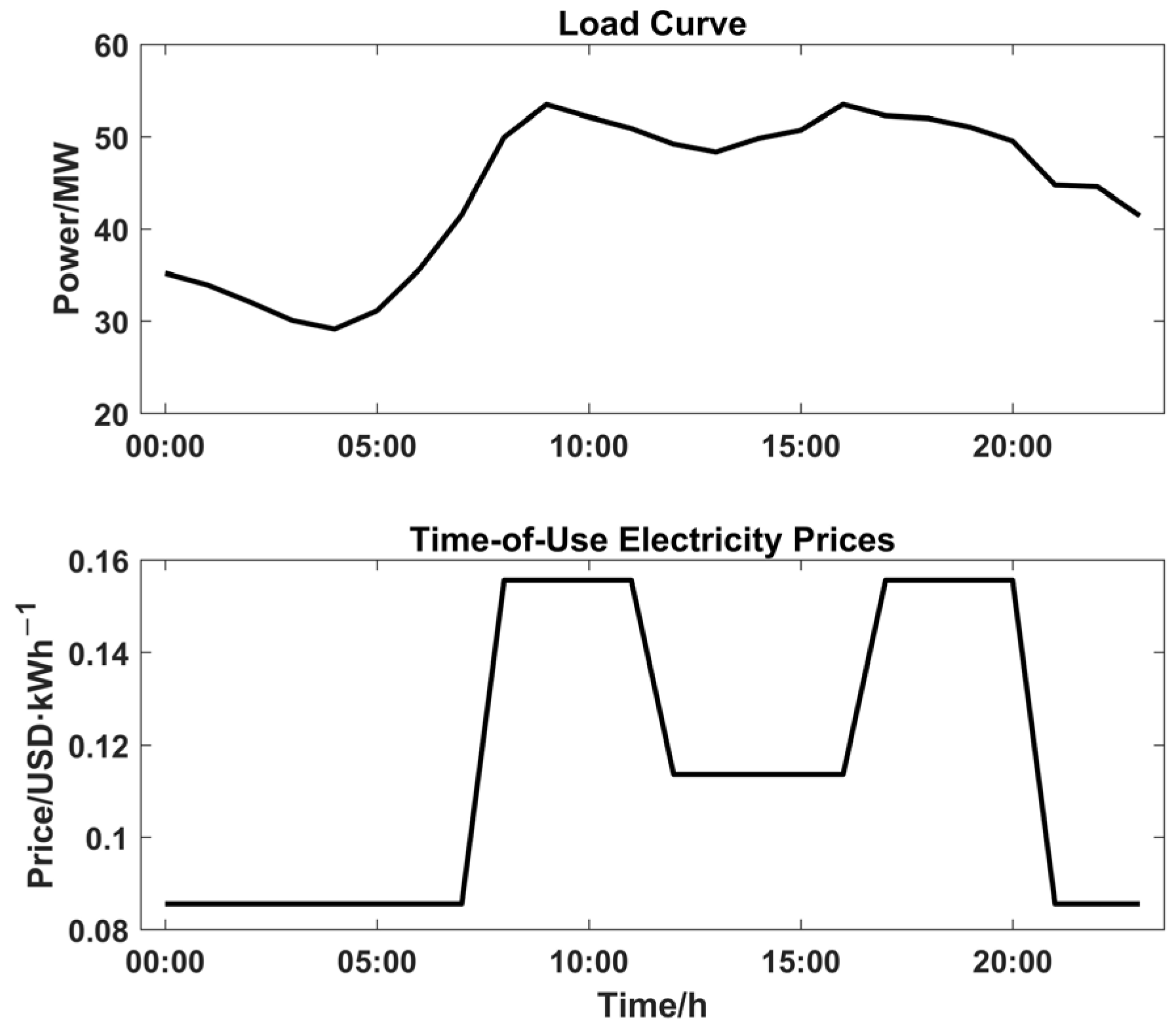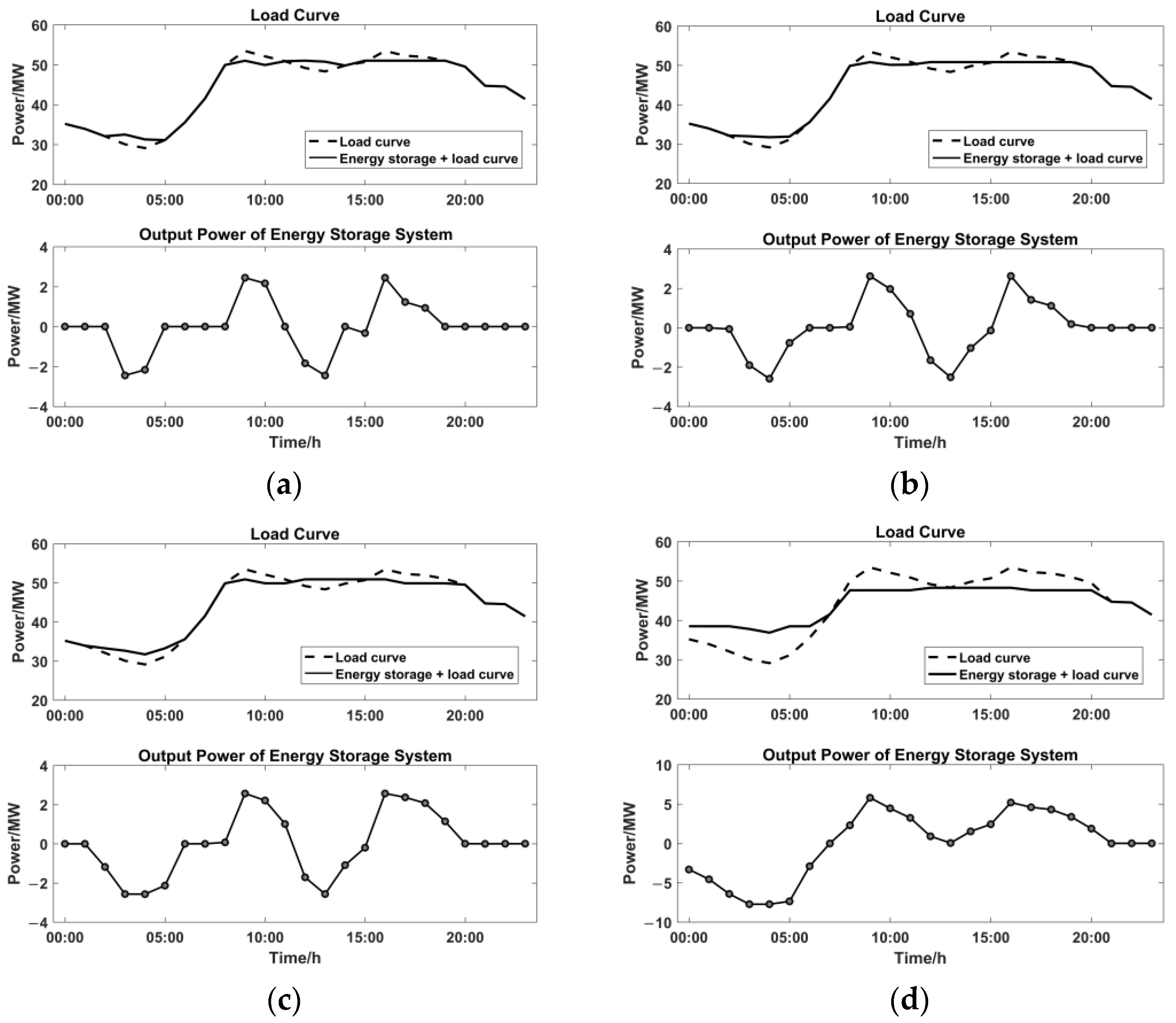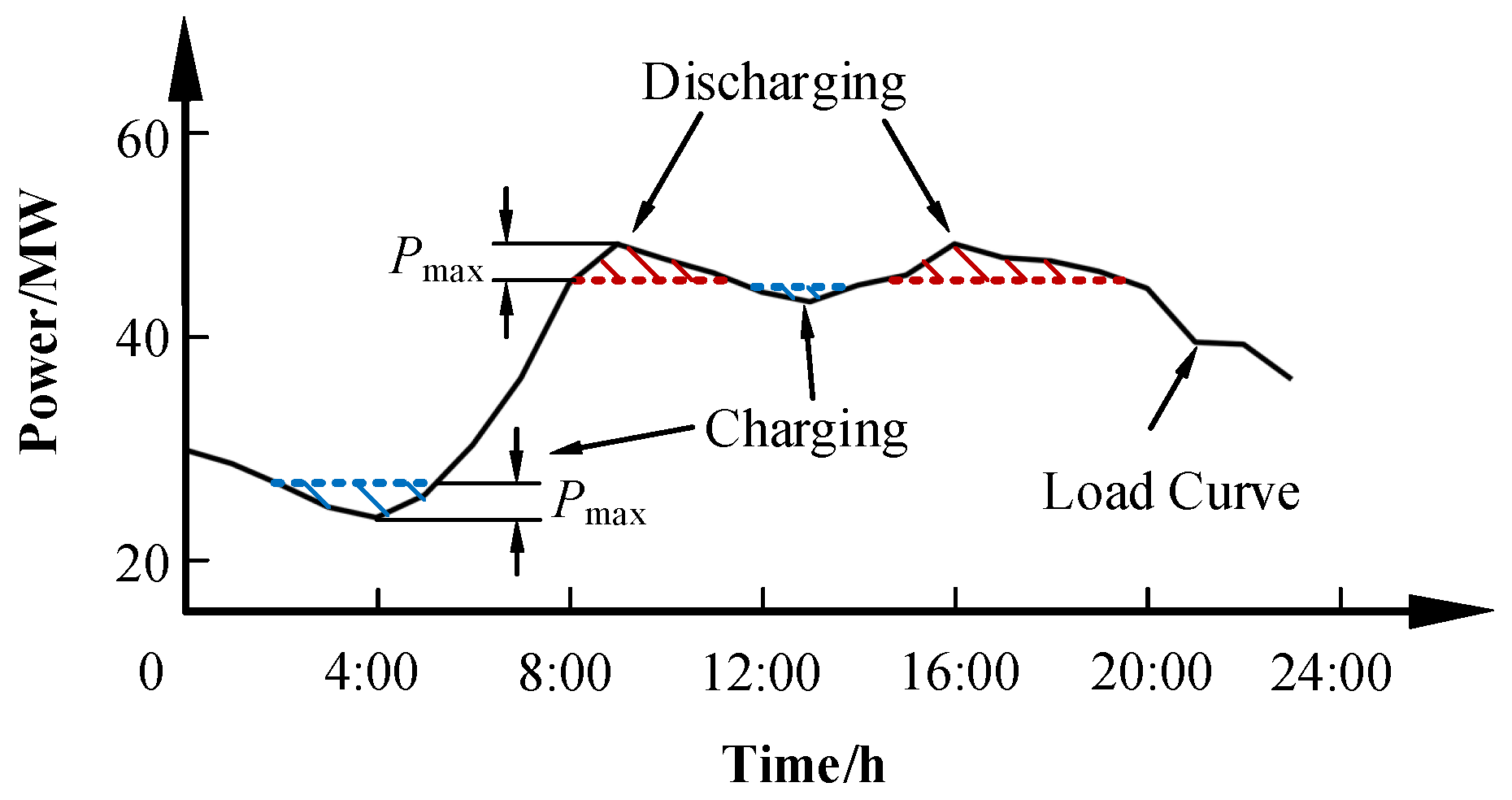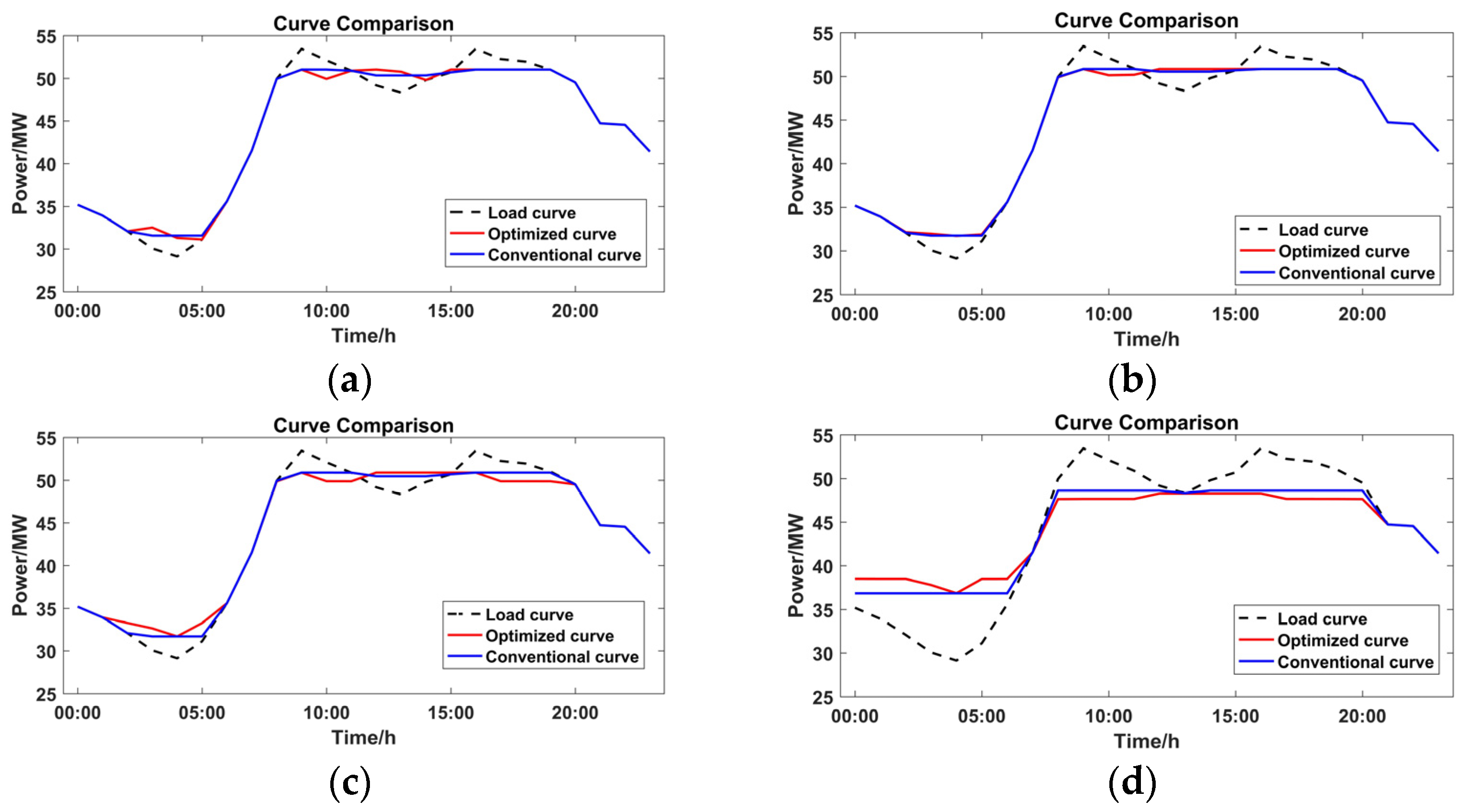Optimized Power and Capacity Configuration Strategy of a Grid-Side Energy Storage System for Peak Regulation
Abstract
:1. Introduction
2. Mathematical Model for Optimization Calculation
2.1. Objective Function
- Investment Cost
- Operation and Maintenance Cost
- Arbitrage in Time-of-Use Electricity Prices
- Government Subsidy
- Potential Benefits
2.2. Restrictions
- Constraints on Rated Power and Capacity
- Output Power Limit for the Energy Storage System
- Conservation of Daily Charge and Discharge
- SOC Limit for Energy Storage Batteries
2.3. Optimization Model
3. Case Study
3.1. Model Data
3.2. Calculation Results
4. Discussion
5. Conclusions
- The objective function of the optimization model includes elements such as the investment, operation and maintenance cost of the energy storage system, arbitrage in time-of-use electricity prices, government subsidy, and social benefits of grid-side energy storage system investment.
- The profitability of the energy storage system under the data is verified through the solution of the cases, and the optimal rated power, capacity, and daily operation mode of the energy storage system under different subjective coefficients are given. The typical daily load curve used in this article has a peak in the morning and one in the afternoon, and the trough is in the early hours of the morning. Therefore, energy storage systems are usually charged at night and in the early hours of the morning, and they are discharged during the day to suppress load peaks.
- The smoothing effect of the energy storage system becomes more important in the optimization calculation with the increase in β, which results in an increase in the power rating and capacity of the energy storage system, and the ability to suppress load peaks more effectively. At the same time, the investment and operation and maintenance costs of energy storage systems will have increased significantly. The increase in economic benefits cannot cover the increase in costs. When the value of B is 5000 or greater, the energy storage system is in a loss-making state. Therefore, in the optimization calculation process, there is a trade-off between economic efficiency and the peak-regulation effect.
- In order to verify the optimization calculation effect, a control group is studied under the same peak-regulation effect. Under this peak-shaving configuration method, the charging and discharging capacity of the energy storage system is lower. There is an overall loss, and the economic benefits are not as good as the optimized calculation results. In Case a and Case b, the energy storage capacity is increased by about 5% in the optimized calculation results, and the daily income is increased by more than 400 USD. In Case c and Case d, the energy storage capacity is significantly increased in the optimization calculation results to enhance the smoothing effect, and at the same time, the daily loss is reduced by about 200 USD.
Author Contributions
Funding
Data Availability Statement
Conflicts of Interest
References
- Rosewater, D.M.; Copp, D.A.; Nguyen, T.A.; Byrne, R.H.; Santoso, S. Battery Energy Storage Models for Optimal Control. IEEE Access 2019, 7, 178357–178391. [Google Scholar]
- Gao, Y.; Zhang, X.; Cheng, Q.; Guo, B.; Yang, J. Classification and Review of the Charging Strategies for Commercial Lithium-Ion Batteries. IEEE Access 2019, 7, 43511–43524. [Google Scholar]
- Boicea, V.A. Energy Storage Technologies: The Past and the Present. Proc. IEEE 2014, 102, 1777–1794. [Google Scholar]
- Hu, X.; Zhang, K.; Liu, K.; Lin, X.; Dey, S.; Onori, S. Advanced Fault Diagnosis for Lithium-Ion Battery Systems: A Review of Fault Mechanisms, Fault Features, and Diagnosis Procedures. IEEE Ind. Electron. Mag. 2020, 14, 65–91. [Google Scholar]
- Balasankar, A.; Arthiya, S.E.; Ramasundaram, S.; Sumathi, P.; Arokiyaraj, S.; Oh, T.; Aruchamy, K.; Sriram, G.; Kurkuri, M.D. Recent Advances in the Preparation and Performance of Porous Titanium-Based Anode Materials for Sodium-Ion Batteries. Energies 2022, 15, 9495. [Google Scholar]
- Faisal, M.; Hannan, M.A.; Ker, P.J.; Hussain, A.; Mansor, M.B.; Blaabjerg, F. Review of Energy Storage System Technologies in Microgrid Applications: Issues and Challenges. IEEE Access 2018, 6, 35143–35164. [Google Scholar]
- Stecca, M.; Elizondo, L.R.; Soeiro, T.B.; Bauer, P.; Palensky, P. A Comprehensive Review of the Integration of Battery Energy Storage Systems into Distribution Networks. IEEE Open J. Ind. Electron. Soc. 2020, 1, 46–65. [Google Scholar]
- Khalid, A.; Stevenson, A.; Sarwat, A.I. Overview of Technical Specifications for Grid-Connected Microgrid Battery Energy Storage Systems. IEEE Access 2021, 9, 163554–163593. [Google Scholar] [CrossRef]
- Li, X.; Wang, S. Energy management and operational control methods for grid battery energy storage systems. CSEE J. Power Energy Syst. 2021, 7, 1026–1040. [Google Scholar]
- Bin, C.; Kun, L.; Xu, Q.; Wenliang, D. Application Research of Anti-island Protection in Hunan Power Grid Side Energy Storage Power Station. In Proceedings of the 2019 Chinese Automation Congress (CAC), Hangzhou, China, 22–24 November 2019; pp. 5355–5358. [Google Scholar]
- Gao, T.; Jiang, L.; Liu, K.; Xiong, D.; Lin, Z.; Bu, W.; Chen, Y. Field Exploration and Analysis of Power Grid Side Battery Energy Storage System. IEEE Access 2021, 9, 63213–63218. [Google Scholar]
- Byrne, R.H.; Nguyen, T.A.; Copp, D.A.; Chalamala, B.R.; Gyuk, I. Energy Management and Optimization Methods for Grid Energy Storage System. IEEE Access 2018, 6, 13231–13260. [Google Scholar] [CrossRef]
- Rouholamini, M.; Wang, C.; Nehrir, H.; Hu, X.; Hu, Z.; Aki, H.; Zhao, B.; Miao, Z.; Strunz, K. A Review of Modeling, Management, and Applications of Grid-Connected Li-Ion Battery Storage Systems. IEEE Trans. Smart Grid 2022, 13, 4505–4524. [Google Scholar] [CrossRef]
- Padmanabhan, N.; Ahmed, M.; Bhattacharya, K. Battery Energy Storage Systems in Energy and Reserve Markets. IEEE Trans. Power Syst. 2020, 35, 215–226. [Google Scholar] [CrossRef]
- Shin, H.; Hur, J. Optimal Energy Storage Sizing with Battery Augmentation for Renewable-Plus-Storage Power Plants. IEEE Access 2020, 8, 187730–187743. [Google Scholar]
- Bui, V.H.; Hussain, A.; Kim, H.M. Double Deep Q-Learning-Based Distributed Operation of Battery Energy Storage System Considering Uncertainties. IEEE Trans. Smart Grid 2020, 11, 457–469. [Google Scholar]
- Cao, J.; Harrold, D.; Fan, Z.; Morstyn, T.; Healey, D.; Li, K. Deep Reinforcement Learning-Based Energy Storage Arbitrage with Accurate Lithium-Ion Battery Degradation Model. IEEE Trans. Smart Grid 2020, 11, 4513–4521. [Google Scholar] [CrossRef]
- Zhang, Y.; Xu, Y.; Yang, H.; Dong, Z.Y.; Zhang, R. Optimal Whole-Life-Cycle Planning of Battery Energy Storage for Multi-Functional Services in Power Systems. IEEE Trans. Sustain. Energy 2020, 11, 2077–2086. [Google Scholar]
- Vu, K.; Ntakou, E.; Schlegelmilch, J.; Muse, L.P.; Fioravanti, R. Energy Equity: Making the Case for Peaker Plant Replacement with Battery Energy Storage. In Proceedings of the 2022 IEEE Electrical Energy Storage Application and Technologies Conference (EESAT), Austin, TX, USA, 8–9 November 2022. [Google Scholar]
- Zhou, C.; Tian, H.; Zhao, L.; Tao, Y.; Chen, K.; Lei, J. Study on comprehensive benefit evaluation method of battery storage to improve new energy consumption. In Proceedings of the 2021 International Conference on Wireless Communications and Smart Grid (ICWCSG), Hangzhou, China, 13–15 August 2021. [Google Scholar]
- Lim, K.J.; Chong, L.W.; Morris, S.; Lim, B.H.; Fahmi, M.; Palanichamy, C. Battery Lifetime and Life Cycle Cost Analysis of Battery-Supercapacitor Hybrid Energy Storage System for Standalone Power System. In Proceedings of the 2022 IEEE 5th International Symposium in Robotics and Manufacturing Automation (ROMA), Malacca, Malaysia, 6–8 August 2022. [Google Scholar]
- Salman, U.T.; Al-Ismail, F.S.; Khalid, M. Optimal Sizing of Battery Energy Storage for Grid-Connected and Isolated Wind-Penetrated Microgrid. IEEE Access 2020, 8, 91129–91138. [Google Scholar] [CrossRef]
- Hong, L.; Li, Y.; Ding, N.; Rizwan, M. Optimal Capacity Allocation Strategy and Economic Analysis of Grid Side-User Side Energy Storage System Based on Cooperative Game. In Proceedings of the 2019 IEEE Sustainable Power and Energy Conference (iSPEC), Beijing, China, 21–23 November 2019. [Google Scholar]
- Lakshmi, S.; Ganguly, S. Centralized and Distributed Battery Energy Storage System for Peak Load Demand Support of Radial Distribution Networks. In Proceedings of the 2019 IEEE Milan PowerTech, Milan, Italy, 23–27 June 2019. [Google Scholar]
- Wong, L.A.; Ramachandaramurthy, V.K.; Walker, S.L.; Ekanayake, J.B. Optimal Placement and Sizing of Battery Energy Storage System Considering the Duck Curve Phenomenon. IEEE Access 2020, 8, 197236–197248. [Google Scholar]
- Pham, Q.V.; Mirjalili, S.; Kumar, N.; Alazab, M.; Hwang, W.J. Whale Optimization Algorithm with Applications to Resource Allocation in Wireless Networks. IEEE Trans. Veh. Technol. 2020, 69, 4285–4297. [Google Scholar] [CrossRef]
- Martinez-Rico, J.; Zulueta, E.; de-Argandoña, I.R.; Fernandez-Gamiz, U.; Armendia, M. Multi-objective Optimization of Production Scheduling Using Particle Swarm Optimization Algorithm for Hybrid Renewable Power Plants with Battery Energy Storage System. J. Mod. Power Syst. Clean Energy 2021, 9, 285–294. [Google Scholar]
- Penangsang, O.; Soeprijanto, A.; Fitriana, A.A.; Ningrum, E.S. Operation optimization stand-alone microgrid using firefly algorithm considering lifetime characteristics of battery. In Proceedings of the 2016 International Seminar on Intelligent Technology and Its Applications (ISITIA), Lombok, Indonesia, 28–30 July 2016. [Google Scholar]
- Saren, G.; Sun, Z.; Liang, T.; Li, H.; Liu, P.; Ma, D.; Zhang, H.; Sun, D.; Yan, J.; Li, C.; et al. An Optimized Control Strategy for Distributed Energy Storage System to Reduce the Peak-valley Difference of Distribution Network. In Proceedings of the 2021 IEEE 4th International Electrical and Energy Conference (CIEEC), Wuhan, China, 28–30 May 2021. [Google Scholar]
- Qi, T.; Wu, Q.; Liu, J.; Xu, F.; Li, Y.; Li, H.; Wang, Y.; Li, C.; Li, J. Capacity and Power Allocation Strategy of Energy Storage Participating in Grid Peak Shaving. In Proceedings of the 2021 IEEE 5th Conference on Energy Internet and Energy System Integration (EI2), Taiyuan, China, 22–24 October 2021. [Google Scholar]




| Parameter | Value | Parameter | Value |
|---|---|---|---|
| ka,b (USD/MWh) | 315,000 | kc (USD/MW) | 67,900 |
| r (%) | 4.2 | n (year) | 10 |
| klt (USD/MW) | 14 | km (USD/MWh) | 12.04 |
| ksp (USD/MW) | 14,000 | es (USD/MWh) | 21 |
| kp (USD/MW) | 167.16 | Pmin (MW) | 1 |
| Pmax (MW) | 10 | Cmin (MWh) | 2 |
| Cmax (MWh) | 50 | Q0 (%) | 10 |
| Qmin (%) | 10 | Qmax (%) | 90 |
| β | P (MW) | C (MWh) | fdi (USD) | fse (MW) |
|---|---|---|---|---|
| 0 | 2.4440 | 5.7627 | 95.4030 | 7.8988 |
| 1000 | 2.6275 | 6.6806 | 91.5096 | 7.8151 |
| 5000 | 2.5701 | 10.564 | −114.409 | 7.5038 |
| 10,000 | 7.7185 | 50.000 | −2502.78 | 4.4281 |
| Case | P (MW) | C (MWh) | fdi (USD) | fse (MW) |
|---|---|---|---|---|
| a | 2.4440 | 5.5049 | −333.6144 | 7.9142 |
| b | 2.6275 | 6.1931 | −360.9550 | 7.8542 |
| c | 2.5701 | 5.9778 | −353.7505 | 7.8728 |
| d | 7.7185 | 38.543 | −2691.292 | 5.2925 |
Disclaimer/Publisher’s Note: The statements, opinions and data contained in all publications are solely those of the individual author(s) and contributor(s) and not of MDPI and/or the editor(s). MDPI and/or the editor(s) disclaim responsibility for any injury to people or property resulting from any ideas, methods, instructions or products referred to in the content. |
© 2023 by the authors. Licensee MDPI, Basel, Switzerland. This article is an open access article distributed under the terms and conditions of the Creative Commons Attribution (CC BY) license (https://creativecommons.org/licenses/by/4.0/).
Share and Cite
Guo, F.; Li, J.; Zhang, C.; Zhu, Y.; Yu, C.; Wang, Q.; Buja, G. Optimized Power and Capacity Configuration Strategy of a Grid-Side Energy Storage System for Peak Regulation. Energies 2023, 16, 5644. https://doi.org/10.3390/en16155644
Guo F, Li J, Zhang C, Zhu Y, Yu C, Wang Q, Buja G. Optimized Power and Capacity Configuration Strategy of a Grid-Side Energy Storage System for Peak Regulation. Energies. 2023; 16(15):5644. https://doi.org/10.3390/en16155644
Chicago/Turabian StyleGuo, Feng, Jian Li, Chi Zhang, Yizhi Zhu, Caiyang Yu, Qingsong Wang, and Giuseppe Buja. 2023. "Optimized Power and Capacity Configuration Strategy of a Grid-Side Energy Storage System for Peak Regulation" Energies 16, no. 15: 5644. https://doi.org/10.3390/en16155644
APA StyleGuo, F., Li, J., Zhang, C., Zhu, Y., Yu, C., Wang, Q., & Buja, G. (2023). Optimized Power and Capacity Configuration Strategy of a Grid-Side Energy Storage System for Peak Regulation. Energies, 16(15), 5644. https://doi.org/10.3390/en16155644








